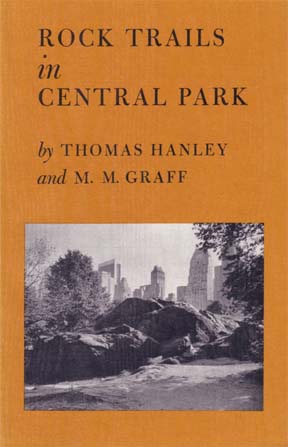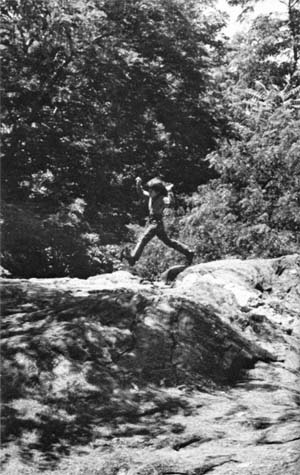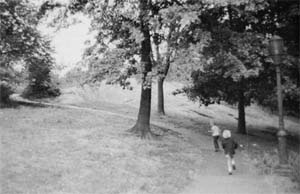City people are more accustomed to orienting themselves by the pattern of city streets than by compass readings. Most New Yorkers would find it easier to locate Fifth Avenue than to recall on which side the sun rises. For convenience, then, the directions in these tours are based on the premise -- inaccurate but simple to grasp -- that uptown is north and downtown south. If you face uptown (north), east is on your right, south at your back and west on your left. Thus when you enter the park from Fifth Avenue (the East Side) and turn right, you are heading north. Central Park South is behind you and Central Park West on your left.
Bringing a compass into the park and attempting to justify these purely arbitrary directions with actual readings would result in utter confusion. It is better to rely on your city-bred sense of which way is downtown to guide you from one outcrop to another.
It is unlikely that you will get lost on the first tour. If you are unable to locate a feature, go back to the last one you were sure of and read the directions again. Paths in the Ramble, however, are devious and it is easy to go astray if you attempt a short cut. You call determine your north-south direction by checking the numbers on lamp posts. The first two numbers indicate the nearest cross street. Thus if you pass #6687 and then come to #6513, you know you are beaded downtown or south.
As far as the crosstown reference is concerned, New Yorkers who have spent a weekend in the country may recall that the sun rises in the east and sets in the west except in winter when it rises in the southeast and sets in the southwest. This is not likely to be of general help, to judge by a young man who, squinting into the rays of the setting sun, asked the way to Central Park West.
Finally, it is advisable to read the text before setting out for the park. A fair grasp of the introductory information -- a thumbnail geologic history, a survey of rock types -- is necessary for an understanding of the complex forces that shaped the area. You can study the background material more comfortably at home than when balancing on the edge of an outcrop.
Central Park is underlain by three distinct layers of rock: a foundation of gneiss, then a layer of marble as much as 2,000 feet thick, and finally an eroded, glaciated mass of schist on the surface.
The foundation of gneiss is thought to be more than a billion years old. Perhaps 500,000 years ago, the eastern edge of this rocky formation sank beneath the sea. Calcite and dolomite precipitated from the sea water, spreading a layer of limestone (later marble) over the existing gneiss basement.
This relatively quiet era was succeeded, some 400,000,000 years ago, by a period of increasing instability. The sinking of the continental shelf became more rapid and volcanoes developed along its seaward edge, covering the limestone with a layer of ash and other sediments, later to become schist.
The weight of the sedimentary deposits in the trough, perhaps 50,000 feet in depth, displaced heavier material below it, thus further disturbing the equilibrium of pressures within the Earth's crust. The exact mechanism of mountain building is still a matter of dispute, but in some manner, stupendous forces compressed the contents of the trough horizontally and thrust them upwards into a chain of high mountains. According to a recent hypothesis, this horizontal pressure may have been exerted by the ocean floor which is thought to have slid under the edge of the continental shelf, thus lifting the deposits in the trough and shouldering them westward against the bulk of the continent.
Miles below the surface, the once-horizontal layers of sedimentary rock were compressed, folded and fractured -- deformed, in the geologists' term. In addition, enormous pressure exerted over long periods of time, combined with intense heat from deep within the Earth, subjected the rocks to metamorphism, a process by which the actual minerological composition of the rocks was changed into entirely new materials. Most of the layers of rock remained distinct, though rendered plastic enough to bend and buckle in response to shifting crustal pressures. However, some portions of rock were melted by extremes of heat and stress. These pools of molten rock were often forced into fractures, creating ribbons of pegmatite and granite which can be clearly traced in the host rock.
The sequence of submersion, volcanism and mountain building was repeated several times. After these upheavals, the area settled down to some 200,000,000 years of peaceful erosion. Rivers carried particles of rock from the mountains and spread them over the plains, providing a favorable basis for the elaboration of plant life. All that survive of the mountains that once towered over the seaboard are their rocky cores, visible as outcrops in Central Park.
The last violent alteration of the New York City terrain occurred about 75,000 years ago when the Wisconsin ice sheet advanced across the area, leaving scars to mark its passage over the rocks of Central Park.
TYPES OF ROCKS
Manhattan Schist
Although there are three major rock types underlying Manhattan Island, only one of them, Manhattan Schist, is exposed in Central Park. This is a layered rock in which mica-bearing bands alternate with layers composed primarily of quartz and feldspar.
Minor Rock Types
As we have seen, the bedrock of Manhattan Island was deposited as sediment on the floor of a shallow inland sea and later transformed by metamorphism. In this category, schist is strongly predominant but is occasionally interlayered with amphibolite, a metamorphosed rock which originated as sediment washed from lava flows of offshore volcanic islands. The other minor rock types, granite and granite pegmatite, are igneous rocks, that is, they entered the host rock as molten material forced into fractures and weak strata by intense pressure within the Earth's crust.
Granite and granite pegmatite -- called pegmatite for convenience -- are essentially of the same mineral composition, a mixture of feldspar, quartz and mica. The distinction lies in the size of the grains which was determined by the rate at which the molten material cooled. Rapid cooling results in small grains. Slow cooling gives opportunity for growth of larger grains. The coarse grains of pegmatite were produced when igneous material was injected into heated rock and cooled Slowly with the surrounding mass. Granite, on the other hand, owes its finer grain to rapid cooling, indicating that it was injected into rock that had lost most of its heat. The large grains of pegmatite make it easy to identify the minerals that compose it: white mica or muscovite, a shiny, silvery mineral that occurs in paper-thin plates; microcline, a variety of feldspar, conspicuous for its salmon-pink color; and quartz, a translucent grayish mineral that resembles lightly smoked glass.
Bands of quartz, evident in many Central Park outcrops, may have originated as injections of molten material, as precipitates from hot water solutions or as deposits of sand on the sea floor. When veins of quartz cut across the layers of the host rock, these are obviously intrusions. However, when such bands lie parallel to the layers, it is not possible to tell whether they are intrusions or sedimentary deposits. We shall see some of these enigmatic bands of quartz at the second stop of the first tour.
 Rock Trails in Central Park
Rock Trails in Central Park



